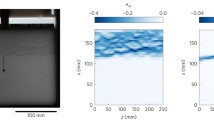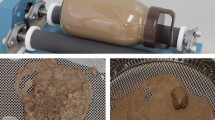Summary
The newly fallen snow exhibits in its large variety of form all the changes in the atmospheric conditions (temperature, moisture, wind), and is a divided, labile matter. After the deposit, the cubic weight increases through the dead weight and the intercrystalline forces. These latter are closely connected with the metamorphosis of the crystals of newly fallen snow, basing on a stability of form. It appears that the snow crystal is covered with a superficial layer of fluid-like properties, and that the surface expansion is responsible for the first phase of the transformation. For the further change into the coarse grained old snow temporal and local differences are necessary. This has been found by observation of nature and of laboratory experiments, and in both cases were the results the same. The snow aggregate possesses, as a whole, a remarkable plasticity; the relations of this latter to the crystal plasticity is, at present, being examined by means of deformation tests. Of the characteristics of the plasticity of crystals a certain firmness and recovery can be observed partly, however, obscured by an elastic after-effect up till now never observed in snow. Of a slow limit there is only a suggestion. Besides mechanical mensurations, microscopic tests are being made on thin grinding plates to get at the individual proceedings.
Similar content being viewed by others
References
Niggli, Bader, Haefeli, Bucher, Neher, Eckel, Thams, Der Schnee und seine Metamorphose (Beiträge z. Geologie d. Schweiz, Geotechn. Serie, Zürich 1939).
A. Papapetrou, Untersuchung über dendritisches Wachstum von Kristallen. Z. Kristallogr.92, 89 (1935).
M. Nakaya und Mitarbeiter, Untersuchungen über natürliche und künstliche Schneekristalle. Übersetzung: Mitteilungen der deutschen Akademie f. Luftfahrtforschung. Bd. 2 (1942).
O. Billwiler, Der Wasseraustausch zwischen der Luft einerseits und Schnee und Eis andererseits im Gebirge. Annalen d. Schweiz. Meteorol. Zentralanstalt (1918).
O. Lütschg, Wasserhaushalt der Schweiz im Hochgebirge, 1. Bd., 1. Teil (erscheint demnächst).
Zum Beispiel Kossel, Über Kristallwachstum, Naturw.44, 901 (1930).
Niggli, Bader, Haefeli, Bucher, Neher, Eckel, Thams, Der Schnee und seine Metamorphose (Beiträge z. Geologie d. Schweiz, Geotechn. Serie, Zürich 1939).
Niggli, Bader, Haefeli, Bucher, Neher, Eckel, Thams, Der Schnee und seine Metamorphose (Beiträge z. Geologie d. Schweiz, Geotechn. Serie, Zürich 1939).
R. Haefeli, Spannungs- und Plastizitätserscheinungen der Schneedecke, Schweizer Archiv f. angew. Wissensch. u. Techn. 9.–12. (1942).
Becker, Z. f. Phys.33, 185 (1925).
W. Siegfried, Spannungszustand und Bruch bei Kriechbeanspruchung, Schweizer Archiv f. angew. Wissensch. u. Techn. 1 (1943). Sprödigkeit und Zähigkeit von Metallen bei hohen Temperaturen. Schweizer Archiv 1. u. 2. (1945).
Niggli, Bader, Haefeli, Bucher, Neher, Eckel, Thams, Der Schnee und seine Metamorphose (Beiträge z. Geologie d. Schweiz, Geotechn. Serie, Zürich 1939).
U. R. Winterhalter, Schneebericht 1939/40 des Eidg. Institutes f. Schnee- und Lawinenforschung.
Author information
Authors and Affiliations
Rights and permissions
About this article
Cite this article
de Quervain, M. Schnee als kristallines Aggregat. Experientia 1, 207–212 (1945). https://doi.org/10.1007/BF02153412
Published:
Issue Date:
DOI: https://doi.org/10.1007/BF02153412




